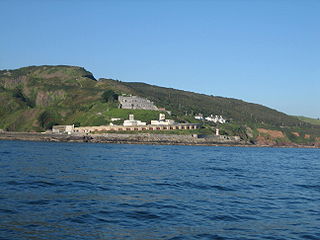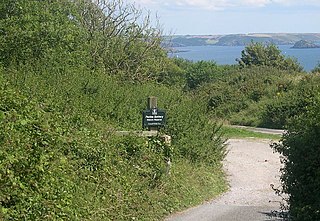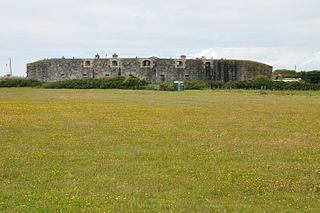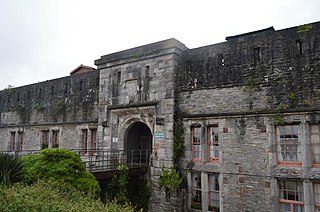
Cawsand and Kingsand are twin villages in southeast Cornwall, England, United Kingdom. The village is situated on the Rame Peninsula and is in the parish of Maker-with-Rame.
Grain Fort is a former artillery fort located just east of the village of Grain, Kent. It was constructed in the 1860s to defend the confluence of the Rivers Medway and Thames during a period of tension with France. The fort's location enabled its guns to support the nearby Grain Tower and Garrison Point Fort at Sheerness on the other side of the Medway. It was repeatedly altered and its guns upgraded at various points in its history, before being decommissioned in 1956 when the UK abolished its coastal defence programme. It was subsequently demolished. The remnants of the fort are still visible and have been incorporated into a coastal park.

Shornemead Fort is a now-disused artillery fort that was built in the 1860s to guard the entrance to the Thames from seaborne attack. Constructed during a period of tension with France, it stands on the south bank of the river at a point where the Thames curves sharply north and west, giving the fort long views up and downriver in both directions. It was the third fort constructed on the site since the 18th century, but its location on marshy ground led to major problems with subsidence. The fort was equipped for a time with a variety of large-calibre artillery guns which were intended to support two other nearby Thamesside forts. However, the extent of the subsidence meant that it became unsafe for the guns to be fired and the fort was disarmed by the early 20th century.

Crownhill Fort is a Royal Commission Fort built in the 1860s in Crownhill as part of Lord Palmerston's ring of land defences for Plymouth. Restored by the Landmark Trust, it is now home to several small businesses, museums, exhibitions and a holiday apartment sleeping up to eight people. The Fort is open to the public on the last Friday of each month and hosts tours for local schools and societies at other times.

Fort Bovisand is a fort in Devon, England near the beach of Bovisand. It was built as a result of the Royal Commission on the Defence of the United Kingdom which reported in 1860. It is located on the mainland to defend the entrance of Plymouth Sound, at the narrows opposite the east end of Plymouth Breakwater. The fort is beside Bovisand harbour.

Penlee Battery is a nature reserve lying on the coastal headland of Penlee Point on the Rame Peninsula, in southeast Cornwall, England.
Portwrinkle is a small coastal village in south-east Cornwall, England, United Kingdom. It is at the western end of Whitsand Bay five miles (8 km) south-west of Saltash.

Tregantle Fort in south east Cornwall is one of several forts surrounding Plymouth that were built as a result of a decision in Lord Palmerston's premiership to deter the French from attacking naval bases on the Channel coast.

The Forgotten Corner of Cornwall is a geographical area of South East Cornwall, Great Britain. It includes the Rame Peninsula and the town of Torpoint, as well as villages like Antony, Downderry, Polbathic, Portwrinkle and Widegates.

Napier of Magdala Battery is a former coastal artillery battery on the south-western cliffs of the British Overseas Territory of Gibraltar, overlooking the Bay of Gibraltar. It also overlooks Rosia Bay from the north, as does Parson's Lodge Battery from the south. It contains one of two surviving Armstrong 100-ton guns.

The RML 12.5-inch guns were large rifled muzzle-loading guns designed for British battleships and were also employed for coast defence.

Hatherwood Battery is a battery located to the east of Alum Bay on the Isle of Wight. It is one of the many Palmerston Forts built on the island to protect it in response to a perceived French invasion. It was sited to cross fire with the nearby Needles Battery

St Catherine's Fort is a 19th-century Palmerston Fort on St Catherine's Island, at Tenby, Pembrokeshire, Wales.

Stamford Fort is a 19th-century fort, built as a result of the Royal Commission on National Defence of 1859. Part of an extensive scheme known as Palmerston Forts, after the prime minister who championed the scheme, it was built to defend the landward approaches to the east of Plymouth, as an element of the plan for the defence of the Royal Naval Dockyard at Devonport. It is 165 feet above sea level, between Jennycliffe Bay and Hooe Lake.
Brownhill Battery is a former gun battery at Staddon Heights, Plymouth, Devon. It was one of a number of Plymouth fortifications to be recommended by the Royal Commission on the Defence of the United Kingdom in 1859. Construction began in 1861, at the same time as Staddon Fort and other defensive works at Staddon Heights. The battery was completed by 1868, but was left unarmed.

Maker Battery is a former 19th-century coastal artillery battery, built to strengthen the defence of the Royal Naval Dockyard at Devonport.

Grenville Battery is a former coastal artillery battery, built to defend the Royal Naval Dockyard at Devonport.

Hawkins Battery is a former coastal artillery battery, built to defend the Royal Naval Dockyard at Devonport.
Tregantle Down Battery was a high angle gun battery in south east Cornwall. It was built between 1888 and 1894 to defend HMNB Devonport from Whitsand Bay area and was infilled to form a car park in the early 1970s.
















